本篇内容主要讲解“zabbix如何配置nginx监控”,感兴趣的朋友不妨来看看。本文介绍的方法操作简单快捷,实用性强。下面就让小编来带大家学习“zabbix如何配置nginx监控”吧!
案例:zabbix 配置 nginx 监控
1. 修改配置文件
vim /usr/local/nginx/conf/nginx.conf location /nginx_status { stub_status; }说明:nginx_status自定义字段,访问地址(例:192.168.169.131/nginx_status)stub_status固定参数# 重启 nginx./nginx reload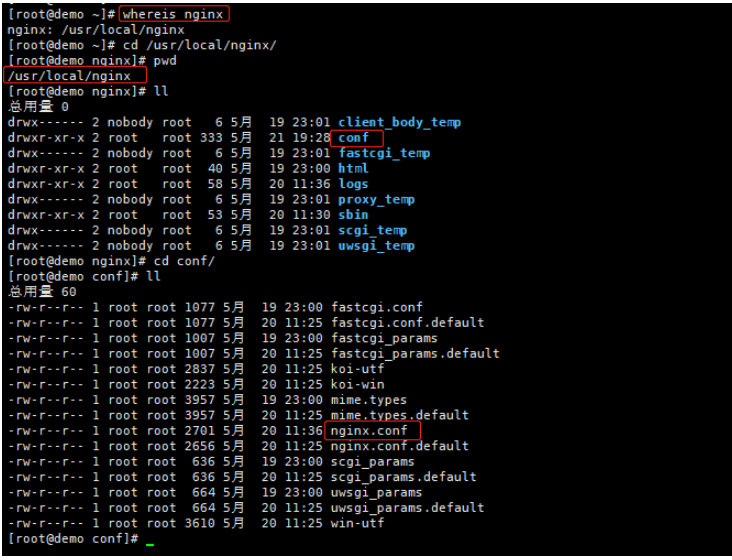
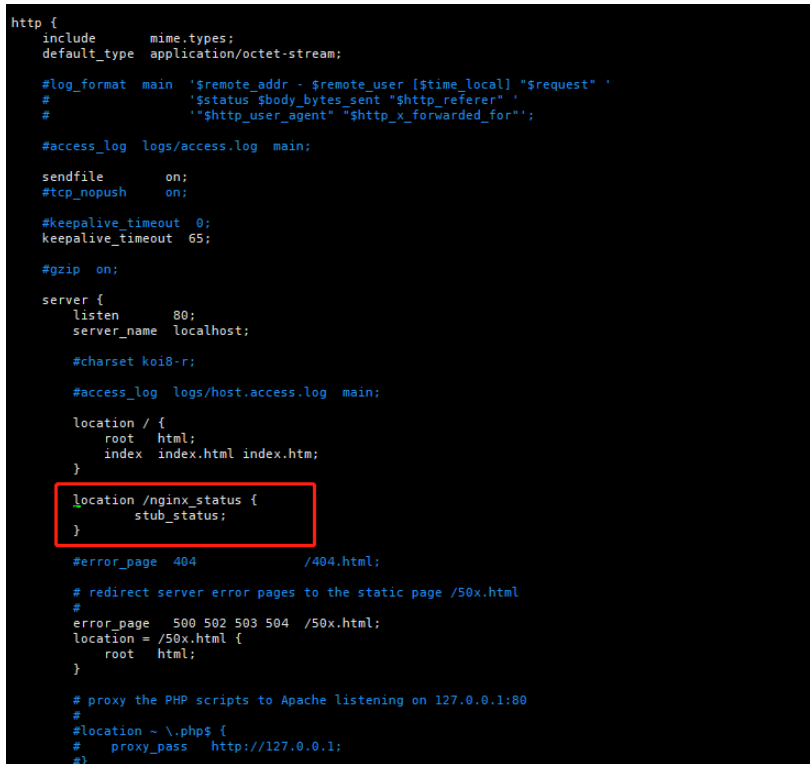
浏览器访问状态说明:Active connections Nginx正处理的活动链接数个数;重要server Nginx启动到现在共处理了多少个连接。accepts Nginx启动到现在共成功创建几次握手。handled requests Nginx总共处理了几次请求。Reading Nginx读取到客户端的 Header 信息数。Writing Nginx返回给客户端的 Header 信息数。Waiting Nginx已经处理完正在等候下一次请求指令的驻留链接,开启。Keep-alive的情况下,Waiting这个值等于active-(reading + writing)。请求丢失数=(握手数-连接数)可以看出,本次状态显示没有丢失请求
2. 编写 nginx 监控脚本
#/bin/bash#Description:Automated monitoring nginx performance and process nginx_status scriptsNGINX_PORT=80 NGINX_COMMAND=$1nginx_ping(){ /sbin/pidof nginx |wc -l }nginx_active(){ /usr/bin/curl -s "http://127.0.0.1:"$NGINX_PORT"/nginx_status/" |awk '/Active/ {print $NF}' }nginx_reading(){ /usr/bin/curl -s "http://127.0.0.1:"$NGINX_PORT"/nginx_status/" |awk '/Reading/ {print $2}' }nginx_writing(){ /usr/bin/curl -s "http://127.0.0.1:"$NGINX_PORT"/nginx_status/" |awk '/Writing/ {print $4}' }nginx_waiting(){ /usr/bin/curl -s "http://127.0.0.1:"$NGINX_PORT"/nginx_status/" |awk '/Waiting/ {print $6}' }nginx_accepts(){ /usr/bin/curl -s "http://127.0.0.1:"$NGINX_PORT"/nginx_status/" |awk 'NR==3 {print $1}' }nginx_handled(){ /usr/bin/curl -s "http://127.0.0.1:"$NGINX_PORT"/nginx_status/" |awk 'NR==3 {print $2}' }nginx_requests(){ /usr/bin/curl -s "http://127.0.0.1:"$NGINX_PORT"/nginx_status/" |awk 'NR==3 {print $3}' }case $NGINX_COMMAND in ping) nginx_ping ;; active) nginx_active ;; reading) nginx_reading ;; writing) nginx_writing ;; waiting) nginx_waiting ;; accepts) nginx_accepts ;; handled) nginx_handled ;; requests) nginx_requests ;; *) echo $"USAGE:$0 {ping|active|reading|writing|waiting|accepts|handled|requests}"esac# 修改文件权限chmod u+x /etc/zabbix/zabbix_agentd.d/zabbix_nginx.sh
3. 修改 zabbix 配置文件
vim /etc/zabbix/zabbix_agentd.d/userparameter_mysql.conf# 增加UserParameter=nginx_status[*],/bin/bash /etc/zabbix/zabbix_agentd.d/zabbix_nginx.sh \$1# 修改完成重启 zabbix-agentsystemctl restart zabbix-agent.service4. 服务端验证
[root@zabbix ~]# zabbix_get -s 192.168.169.131 -k nginx_status[active]5. 添加模块
模块名称:Template Nginx Web Status Monitor(自定义)
可见名称:NGINX STATUS MONITOR(自定义)

6. 创建应用集
名称:NGINX_STATUS
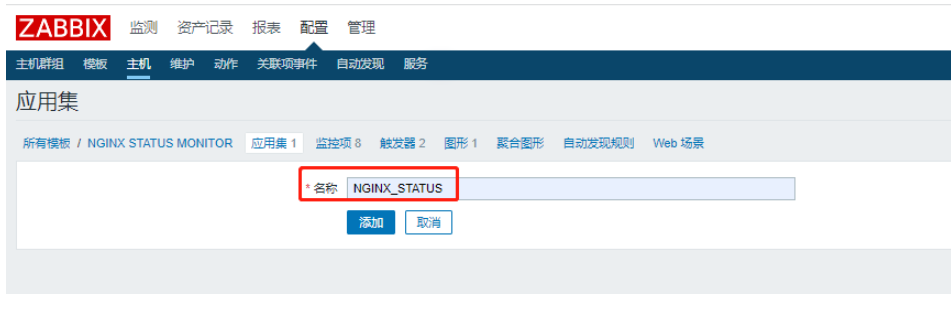
7. 创建监控项
名称:Nginx_Status_Ping
键值:nginx_status[ping]
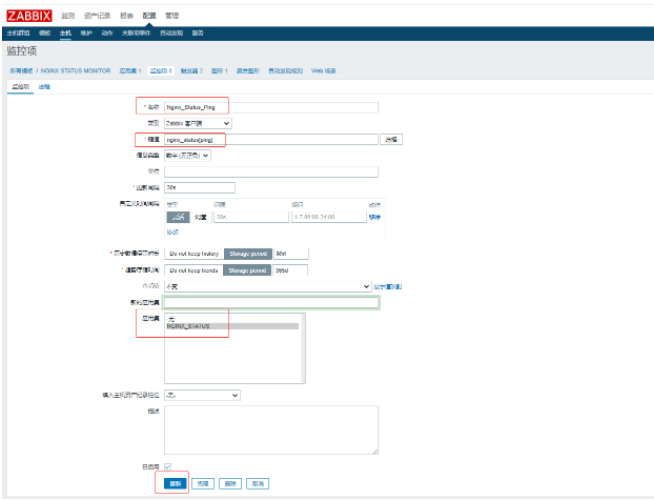
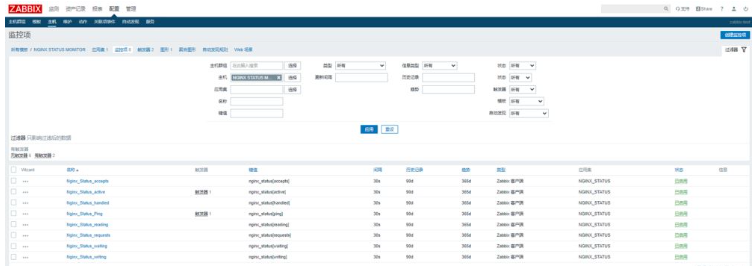
8. 定义触发器
超过50个并发连接就执行报警

nginx 服务down了执行报警
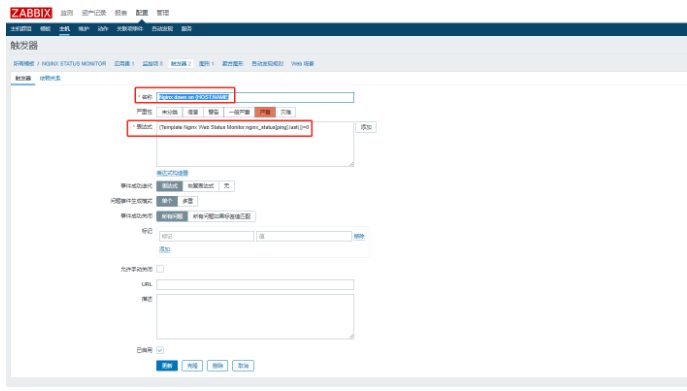
9. 关联主机
将需要监控的主机添加上此模板
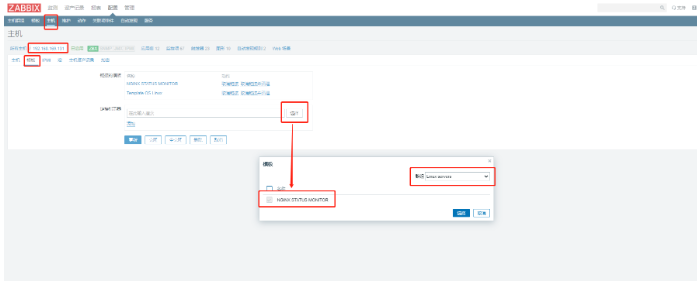
10. nginx 模板文件
zbx_export_templates.xml
<?xml version="1.0" encoding="UTF-8"?><zabbix_export> <version>4.0</version> <date>2022-05-21T12:29:43Z</date> <groups> <group> <name>Linux servers</name> </group> </groups> <templates> <template> <template>Template Nginx Web Status Monitor</template> <name>NGINX STATUS MONITOR</name> <description/> <groups> <group> <name>Linux servers</name> </group> </groups> <applications> <application> <name>NGINX_STATUS</name> </application> </applications> <items> <item> <name>Nginx_Status_accepts</name> <type>0</type> <snmp_community/> <snmp_oid/> <key>nginx_status[accepts]</key> <delay>30s</delay> <history>90d</history> <trends>365d</trends> <status>0</status> <value_type>3</value_type> <allowed_hosts/> <units/> <snmpv3_contextname/> <snmpv3_securityname/> <snmpv3_securitylevel>0</snmpv3_securitylevel> <snmpv3_authprotocol>0</snmpv3_authprotocol> <snmpv3_authpassphrase/> <snmpv3_privprotocol>0</snmpv3_privprotocol> <snmpv3_privpassphrase/> <params/> <ipmi_sensor/> <authtype>0</authtype> <username/> <password/> <publickey/> <privatekey/> <port/> <description/> <inventory_link>0</inventory_link> <applications> <application> <name>NGINX_STATUS</name> </application> </applications> <valuemap/> <logtimefmt/> <preprocessing/> <jmx_endpoint/> <timeout>3s</timeout> <url/> <query_fields/> <posts/> <status_codes>200</status_codes> <follow_redirects>1</follow_redirects> <post_type>0</post_type> <http_proxy/> <headers/> <retrieve_mode>0</retrieve_mode> <request_method>0</request_method> <output_format>0</output_format> <allow_traps>0</allow_traps> <ssl_cert_file/> <ssl_key_file/> <ssl_key_password/> <verify_peer>0</verify_peer> <verify_host>0</verify_host> <master_item/> </item> <item> <name>Nginx_Status_active</name> <type>0</type> <snmp_community/> <snmp_oid/> <key>nginx_status[active]</key> <delay>30s</delay> <history>90d</history> <trends>365d</trends> <status>0</status> <value_type>3</value_type> <allowed_hosts/> <units/> <snmpv3_contextname/> <snmpv3_securityname/> <snmpv3_securitylevel>0</snmpv3_securitylevel> <snmpv3_authprotocol>0</snmpv3_authprotocol> <snmpv3_authpassphrase/> <snmpv3_privprotocol>0</snmpv3_privprotocol> <snmpv3_privpassphrase/> <params/> <ipmi_sensor/> <authtype>0</authtype> <username/> <password/> <publickey/> <privatekey/> <port/> <description/> <inventory_link>0</inventory_link> <applications> <application> <name>NGINX_STATUS</name> </application> </applications> <valuemap/> <logtimefmt/> <preprocessing/> <jmx_endpoint/> <timeout>3s</timeout> <url/> <query_fields/> <posts/> <status_codes>200</status_codes> <follow_redirects>1</follow_redirects> <post_type>0</post_type> <http_proxy/> <headers/> <retrieve_mode>0</retrieve_mode> <request_method>0</request_method> <output_format>0</output_format> <allow_traps>0</allow_traps> <ssl_cert_file/> <ssl_key_file/> <ssl_key_password/> <verify_peer>0</verify_peer> <verify_host>0</verify_host> <master_item/> </item> <item> <name>Nginx_Status_handled</name> <type>0</type> <snmp_community/> <snmp_oid/> <key>nginx_status[handled]</key> <delay>30s</delay> <history>90d</history> <trends>365d</trends> <status>0</status> <value_type>3</value_type> <allowed_hosts/> <units/> <snmpv3_contextname/> <snmpv3_securityname/> <snmpv3_securitylevel>0</snmpv3_securitylevel> <snmpv3_authprotocol>0</snmpv3_authprotocol> <snmpv3_authpassphrase/> <snmpv3_privprotocol>0</snmpv3_privprotocol> <snmpv3_privpassphrase/> <params/> <ipmi_sensor/> <authtype>0</authtype> <username/> <password/> <publickey/> <privatekey/> <port/> <description/> <inventory_link>0</inventory_link> <applications> <application> <name>NGINX_STATUS</name> </application> </applications> <valuemap/> <logtimefmt/> <preprocessing/> <jmx_endpoint/> <timeout>3s</timeout> <url/> <query_fields/> <posts/> <status_codes>200</status_codes> <follow_redirects>1</follow_redirects> <post_type>0</post_type> <http_proxy/> <headers/> <retrieve_mode>0</retrieve_mode> <request_method>0</request_method> <output_format>0</output_format> <allow_traps>0</allow_traps> <ssl_cert_file/> <ssl_key_file/> <ssl_key_password/> <verify_peer>0</verify_peer> <verify_host>0</verify_host> <master_item/> </item> <item> <name>Nginx_Status_Ping</name> <type>0</type> <snmp_community/> <snmp_oid/> <key>nginx_status[ping]</key> <delay>30s</delay> <history>90d</history> <trends>365d</trends> <status>0</status> <value_type>3</value_type> <allowed_hosts/> <units/> <snmpv3_contextname/> <snmpv3_securityname/> <snmpv3_securitylevel>0</snmpv3_securitylevel> <snmpv3_authprotocol>0</snmpv3_authprotocol> <snmpv3_authpassphrase/> <snmpv3_privprotocol>0</snmpv3_privprotocol> <snmpv3_privpassphrase/> <params/> <ipmi_sensor/> <authtype>0</authtype> <username/> <password/> <publickey/> <privatekey/> <port/> <description/> <inventory_link>0</inventory_link> <applications> <application> <name>NGINX_STATUS</name> </application> </applications> <valuemap/> <logtimefmt/> <preprocessing/> <jmx_endpoint/> <timeout>3s</timeout> <url/> <query_fields/> <posts/> <status_codes>200</status_codes> <follow_redirects>1</follow_redirects> <post_type>0</post_type> <http_proxy/> <headers/> <retrieve_mode>0</retrieve_mode> <request_method>0</request_method> <output_format>0</output_format> <allow_traps>0</allow_traps> <ssl_cert_file/> <ssl_key_file/> <ssl_key_password/> <verify_peer>0</verify_peer> <verify_host>0</verify_host> <master_item/> </item> <item> <name>Nginx_Status_reading</name> <type>0</type> <snmp_community/> <snmp_oid/> <key>nginx_status[reading]</key> <delay>30s</delay> <history>90d</history> <trends>365d</trends> <status>0</status> <value_type>3</value_type> <allowed_hosts/> <units/> <snmpv3_contextname/> <snmpv3_securityname/> <snmpv3_securitylevel>0</snmpv3_securitylevel> <snmpv3_authprotocol>0</snmpv3_authprotocol> <snmpv3_authpassphrase/> <snmpv3_privprotocol>0</snmpv3_privprotocol> <snmpv3_privpassphrase/> <params/> <ipmi_sensor/> <authtype>0</authtype> <username/> <password/> <publickey/> <privatekey/> <port/> <description/> <inventory_link>0</inventory_link> <applications> <application> <name>NGINX_STATUS</name> </application> </applications> <valuemap/> <logtimefmt/> <preprocessing/> <jmx_endpoint/> <timeout>3s</timeout> <url/> <query_fields/> <posts/> <status_codes>200</status_codes> <follow_redirects>1</follow_redirects> <post_type>0</post_type> <http_proxy/> <headers/> <retrieve_mode>0</retrieve_mode> <request_method>0</request_method> <output_format>0</output_format> <allow_traps>0</allow_traps> <ssl_cert_file/> <ssl_key_file/> <ssl_key_password/> <verify_peer>0</verify_peer> <verify_host>0</verify_host> <master_item/> </item> <item> <name>Nginx_Status_requests</name> <type>0</type> <snmp_community/> <snmp_oid/> <key>nginx_status[requests]</key> <delay>30s</delay> <history>90d</history> <trends>365d</trends> <status>0</status> <value_type>3</value_type> <allowed_hosts/> <units/> <snmpv3_contextname/> <snmpv3_securityname/> <snmpv3_securitylevel>0</snmpv3_securitylevel> <snmpv3_authprotocol>0</snmpv3_authprotocol> <snmpv3_authpassphrase/> <snmpv3_privprotocol>0</snmpv3_privprotocol> <snmpv3_privpassphrase/> <params/> <ipmi_sensor/> <authtype>0</authtype> <username/> <password/> <publickey/> <privatekey/> <port/> <description/> <inventory_link>0</inventory_link> <applications> <application> <name>NGINX_STATUS</name> </application> </applications> <valuemap/> <logtimefmt/> <preprocessing/> <jmx_endpoint/> <timeout>3s</timeout> <url/> <query_fields/> <posts/> <status_codes>200</status_codes> <follow_redirects>1</follow_redirects> <post_type>0</post_type> <http_proxy/> <headers/> <retrieve_mode>0</retrieve_mode> <request_method>0</request_method> <output_format>0</output_format> <allow_traps>0</allow_traps> <ssl_cert_file/> <ssl_key_file/> <ssl_key_password/> <verify_peer>0</verify_peer> <verify_host>0</verify_host> <master_item/> </item> <item> <name>Nginx_Status_waiting</name> <type>0</type> <snmp_community/> <snmp_oid/> <key>nginx_status[waiting]</key> <delay>30s</delay> <history>90d</history> <trends>365d</trends> <status>0</status> <value_type>3</value_type> <allowed_hosts/> <units/> <snmpv3_contextname/> <snmpv3_securityname/> <snmpv3_securitylevel>0</snmpv3_securitylevel> <snmpv3_authprotocol>0</snmpv3_authprotocol> <snmpv3_authpassphrase/> <snmpv3_privprotocol>0</snmpv3_privprotocol> <snmpv3_privpassphrase/> <params/> <ipmi_sensor/> <authtype>0</authtype> <username/> <password/> <publickey/> <privatekey/> <port/> <description/> <inventory_link>0</inventory_link> <applications> <application> <name>NGINX_STATUS</name> </application> </applications> <valuemap/> <logtimefmt/> <preprocessing/> <jmx_endpoint/> <timeout>3s</timeout> <url/> <query_fields/> <posts/> <status_codes>200</status_codes> <follow_redirects>1</follow_redirects> <post_type>0</post_type> <http_proxy/> <headers/> <retrieve_mode>0</retrieve_mode> <request_method>0</request_method> <output_format>0</output_format> <allow_traps>0</allow_traps> <ssl_cert_file/> <ssl_key_file/> <ssl_key_password/> <verify_peer>0</verify_peer> <verify_host>0</verify_host> <master_item/> </item> <item> <name>Nginx_Status_writing</name> <type>0</type> <snmp_community/> <snmp_oid/> <key>nginx_status[writing]</key> <delay>30s</delay> <history>90d</history> <trends>365d</trends> <status>0</status> <value_type>3</value_type> <allowed_hosts/> <units/> <snmpv3_contextname/> <snmpv3_securityname/> <snmpv3_securitylevel>0</snmpv3_securitylevel> <snmpv3_authprotocol>0</snmpv3_authprotocol> <snmpv3_authpassphrase/> <snmpv3_privprotocol>0</snmpv3_privprotocol> <snmpv3_privpassphrase/> <params/> <ipmi_sensor/> <authtype>0</authtype> <username/> <password/> <publickey/> <privatekey/> <port/> <description/> <inventory_link>0</inventory_link> <applications> <application> <name>NGINX_STATUS</name> </application> </applications> <valuemap/> <logtimefmt/> <preprocessing/> <jmx_endpoint/> <timeout>3s</timeout> <url/> <query_fields/> <posts/> <status_codes>200</status_codes> <follow_redirects>1</follow_redirects> <post_type>0</post_type> <http_proxy/> <headers/> <retrieve_mode>0</retrieve_mode> <request_method>0</request_method> <output_format>0</output_format> <allow_traps>0</allow_traps> <ssl_cert_file/> <ssl_key_file/> <ssl_key_password/> <verify_peer>0</verify_peer> <verify_host>0</verify_host> <master_item/> </item> </items> <discovery_rules/> <httptests/> <macros/> <templates/> <screens/> </template> </templates> <triggers> <trigger> <expression>{Template Nginx Web Status Monitor:nginx_status[active].last()}>50</expression> <recovery_mode>0</recovery_mode> <recovery_expression/> <name>Excessive number of active links in nginx</name> <correlation_mode>0</correlation_mode> <correlation_tag/> <url/> <status>0</status> <priority>4</priority> <description/> <type>0</type> <manual_close>0</manual_close> <dependencies/> <tags/> </trigger> <trigger> <expression>{Template Nginx Web Status Monitor:nginx_status[ping].last()}=0</expression> <recovery_mode>0</recovery_mode> <recovery_expression/> <name>Nginx down on {HOST.NAME}</name> <correlation_mode>0</correlation_mode> <correlation_tag/> <url/> <status>0</status> <priority>4</priority> <description/> <type>0</type> <manual_close>0</manual_close> <dependencies/> <tags/> </trigger> </triggers> <graphs> <graph> <name>Nginx_Status</name> <width>900</width> <height>200</height> <yaxismin>0.0000</yaxismin> <yaxismax>100.0000</yaxismax> <show_work_period>1</show_work_period> <show_triggers>1</show_triggers> <type>0</type> <show_legend>1</show_legend> <show_3d>0</show_3d> <percent_left>0.0000</percent_left> <percent_right>0.0000</percent_right> <ymin_type_1>0</ymin_type_1> <ymax_type_1>0</ymax_type_1> <ymin_item_1>0</ymin_item_1> <ymax_item_1>0</ymax_item_1> <graph_items> <graph_item> <sortorder>1</sortorder> <drawtype>0</drawtype> <color>1A7C11</color> <yaxisside>0</yaxisside> <calc_fnc>2</calc_fnc> <type>0</type> <item> <host>Template Nginx Web Status Monitor</host> <key>nginx_status[accepts]</key> </item> </graph_item> <graph_item> <sortorder>2</sortorder> <drawtype>0</drawtype> <color>F63100</color> <yaxisside>0</yaxisside> <calc_fnc>2</calc_fnc> <type>0</type> <item> <host>Template Nginx Web Status Monitor</host> <key>nginx_status[active]</key> </item> </graph_item> <graph_item> <sortorder>3</sortorder> <drawtype>0</drawtype> <color>2774A4</color> <yaxisside>0</yaxisside> <calc_fnc>2</calc_fnc> <type>0</type> <item> <host>Template Nginx Web Status Monitor</host> <key>nginx_status[handled]</key> </item> </graph_item> <graph_item> <sortorder>4</sortorder> <drawtype>0</drawtype> <color>A54F10</color> <yaxisside>0</yaxisside> <calc_fnc>2</calc_fnc> <type>0</type> <item> <host>Template Nginx Web Status Monitor</host> <key>nginx_status[ping]</key> </item> </graph_item> <graph_item> <sortorder>5</sortorder> <drawtype>0</drawtype> <color>FC6EA3</color> <yaxisside>0</yaxisside> <calc_fnc>2</calc_fnc> <type>0</type> <item> <host>Template Nginx Web Status Monitor</host> <key>nginx_status[reading]</key> </item> </graph_item> <graph_item> <sortorder>6</sortorder> <drawtype>0</drawtype> <color>6C59DC</color> <yaxisside>0</yaxisside> <calc_fnc>2</calc_fnc> <type>0</type> <item> <host>Template Nginx Web Status Monitor</host> <key>nginx_status[requests]</key> </item> </graph_item> <graph_item> <sortorder>7</sortorder> <drawtype>0</drawtype> <color>AC8C14</color> <yaxisside>0</yaxisside> <calc_fnc>2</calc_fnc> <type>0</type> <item> <host>Template Nginx Web Status Monitor</host> <key>nginx_status[waiting]</key> </item> </graph_item> <graph_item> <sortorder>8</sortorder> <drawtype>0</drawtype> <color>611F27</color> <yaxisside>0</yaxisside> <calc_fnc>2</calc_fnc> <type>0</type> <item> <host>Template Nginx Web Status Monitor</host> <key>nginx_status[writing]</key> </item> </graph_item> </graph_items> </graph> </graphs></zabbix_export>到此,相信大家对“zabbix如何配置nginx监控”有了更深的了解,不妨来实际操作一番吧!这里是编程网网站,更多相关内容可以进入相关频道进行查询,关注我们,继续学习!






